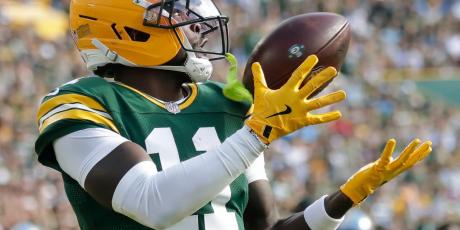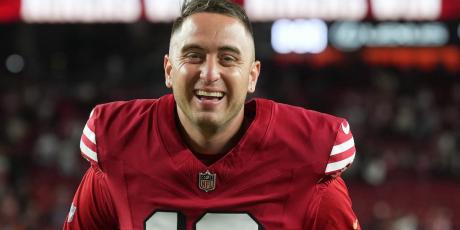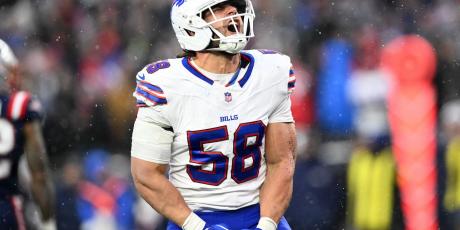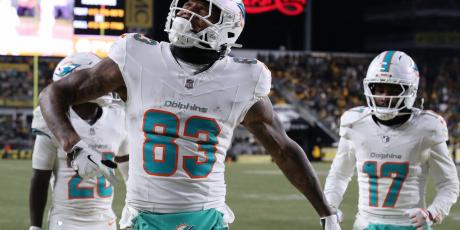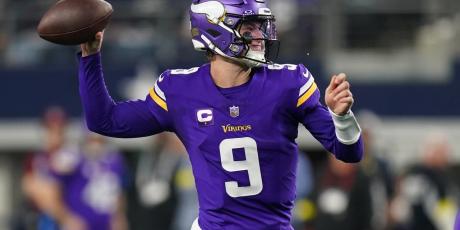Why Streaming Defense in Fantasy Football Works and How to Do It

Streaming defenses is one of the best strategies in fantasy football—and it's becoming more popular.
For those unfamiliar, to stream your defense is to avoid worrying about its long-term outlook or using a high pick when drafting because you're instead going to acquire the defense with the best matchup that is available on the waiver wire each week.
Editor's Note: Click here for 2018 D/ST streaming draft strategy edition.
- Fantasy Strength of Schedule Rankings: QB | RB | WR | TE | K | DEF
- Fantasy Strength of Schedule Hot Spots: By Player | By Position
- More 2017 Positional Draft Strategies: QB | WR | Zero RB | TE | IDP | PR & KR
Why Streaming Your Fantasy Defense Will Work in 2017
In seasons past, it was a popular practice to just use the final rounds of your draft to fill out your roster by picking the best defense(s) available. However, there are now only a handful defenses that are dominant, and even they are capable of putting up a fantasy dud on a given week given the variance inherent to the position. The modern-day NFL game has been changing, and the rules now strongly favor quarterbacks and high-scoring offense.
According to MyFantasyLeague ADP, the Broncos were the first defense to come off the board in 2016, with an ADP of 94.9 (which is around the eighth round of a 12-team draft). At that spot, you could have had your choice of Michael Crabtree (89.9), Frank Gore (92.4), Zach Ertz (98.3), or Jay Ajayi (105.9). While Denver's defense finished fourth at the position with an average of 9.5 fantasy points per game, it was not nearly as valuable as Crabtree, who averaged 14.8 fantasy points per game (PPR) and finished as the WR12. Neither were the Broncos as valuable as Ajayi (14.4, RB11), Ertz (13.6), or Gore (13.4, RB12).
The point of streaming is to load your roster up with high-upside or consistent producers, then using your last pick on a defense to stream in Week 1. In looking at 2016 ADP, it becomes clear why spending an early pick on a defense can be a mistake:
| Rank | Team | ADP | FP | FP/G |
|---|---|---|---|---|
| 1 | DEN | 94.9 | 151.5 | 9.5 |
| 2 | SEA | 97.4 | 128.5 | 8.0 |
| 3 | ARI | 106.7 | 156.5 | 9.8 |
| 4 | CAR | 112.6 | 134.5 | 8.4 |
| 5 | ATL | 117.5 | 120.0 | 7.5 |
| 6 | KC | 119.2 | 175.0 | 10.9 |
| 7 | HOU | 121.0 | 96.0 | 6.0 |
| 8 | DAL | 131.7 | 97.0 | 6.1 |
| 9 | NE | 137.8 | 133.0 | 8.3 |
| 10 | MIN | 140.3 | 168.0 | 10.5 |
| 11 | GB | 146.2 | 111.5 | 7.0 |
| 12 | PIT | 147.4 | 117.5 | 7.3 |
| 13 | CIN | 149.7 | 102.5 | 6.4 |
| 14 | LAR | 150.0 | 100.0 | 6.3 |
| 15 | NYG | 155.5 | 142.0 | 8.9 |
| 16 | OAK | 159.6 | 100.0 | 6.3 |
| 17 | DET | 161.4 | 93.5 | 5.8 |
| 18 | NYJ | 166.5 | 70.0 | 4.4 |
| 19 | MIA | 169.7 | 122.0 | 7.6 |
| 20 | PHI | 172.6 | 146.0 | 9.1 |
| 21 | BUF | 176.0 | 117.5 | 7.3 |
| 22 | JAX | 185.2 | 75.5 | 4.7 |
| 23 | BAL | 195.8 | 128.5 | 8.0 |
| 24 | IND | 197.2 | 92.5 | 5.8 |
| 25 | CHI | 199.3 | 95.5 | 6.0 |
| 26 | SF | 204.5 | 85.0 | 5.3 |
| 27 | TB | 210.5 | 147.0 | 9.2 |
| LAC | 133.5 | 8.3 | ||
| TEN | 95.5 | 6.0 | ||
| WAS | 89.5 | 5.6 | ||
| NO | 78.0 | 4.9 | ||
| CLE | 59.5 | 3.7 |
What screams at you is that a hardly drafted defense like the Chargers was outscored by the Broncos defense by a meager 1.1 points per game. The Chargers could have been your last pick and scored just as many points as a defense taken 10-plus rounds earlier—and that's without even streaming. By the same token, the Eagles' ADP was 20th, while the Buccaneers' was 27th, and both defenses scored nearly as many points as the Broncos; 10 defenses outscored the Seahawks, who were the second defense taken in most drafts.
This season, drafters have gotten more savvy—the first defense off the board (Denver) has an ADP on MFL in the 12th round—but streaming defenses is still a better option than being one of the first drafters in your league to select one.
Related: How to Pair Fantasy Defenses to Get An Easy Strength of Schedule
When streaming a defense, there are four factors I take into consideration.
1. NFL Stats That Indicate How Good/Bad an Offense Is
More times than not, picking on a bad offense is going to work in your favor. Last season, the Browns and Rams were two offenses we could pick on and expect top-10 results from our defense. Bad offenses tend to have bad quarterback play, below-average offensive lines, and few offensive weapons, which each combine to result in few points allowed and big plays for the defense, namely sacks, turnovers, and touchdowns.
In the context of the matchup for a fantasy defense, there are three main statistics that provide a good indication of how good or bad an offense is:
Points Per Game
Nothing signals a bad offense more than being one that fails to score many points. In 2016, these were the bottom-five scoring offenses in terms of points per game:
- Rams: 14.0
- Browns: 16.5
- Jets: 17.2
- Bears: 17.4
- Texans: 17.4
Turnover Differential
Target offenses that negative turnover differentials provides upside because turnovers are the plays where defensive touchdowns can occur. Here are the bottom five offenses in that category in 2016:
- Bears: -20
- Jets: -20
- Jaguars: -16
- Browns: -12
- Rams: -11
Those five offenses were the only ones that had a negative turnover differential in the double-digits. The Jets and Rams were also among the top three lowest scoring teams, so it's no surprise they were both generous with turnovers; each team threw 20+ interceptions.
Pressure Rate
Sacks are prone to regression, but we can use pressure rate to help project sacks; pressures tend to turn into sacks, which lead to fantasy points for our defense. According to FootballOutsiders, these offenses had the highest allowed pressure rates in 2016:
- Seahawks: 35.1%
- Colts: 33.4%
- Bills: 32.4%
- Browns: 31.0%
- Cardinals: 31.0%
- Texans: 30.2%
- Buccaneers: 30.2%
- Falcons: 29.7%
- 49ers: 29.1%
- Cowboys: 29.0%
The Falcons and Cowboys were typically offenses we didn't want to pick on with a streamer, but each fo the other eight finished no higher than 13th in aFPA to opposing defenses. Heading into 2017, the Jets still appear to be an offense we can target, as well as the Bears, Texans, and Rams. The Browns played the role of turnstile last year, allowing 66 sacks, and while they have improved their offensive line, they still remain an offense we can pick on until further notice.
2. The NFL Injury Report
Injuries on the both sides of the ball are key to monitor. There are three main injuries to look out for.
Injury to the Quarterback
The NFL is a quarterback-driven league, so if an offense has to start their second- or third-string quarterback, the opposing defense quickly jumps to the top of the streaming list. Backup quarterbacks have a propensity to hold the ball longer, which leads to more sacks and fumbles. And mounting pressure can also lead to errant throws which are increasingly likely to result in interceptions.
Injury to a Key Offensive Contributor
If a team has lost one of its key offensive contributors, the defense will tend to key in and expose his replacement of lesser talent. There are exceptions to that rule, however: last season, LeVeon Bell was suspended for the first three games and his backup, DeAngelo Williams, produced 237 rushing yards, 10 catches resulting in 66 yards, and three total scores (although he was stifled by the Eagles defense in Week 3). It's important to look at the offensive system of the team your streamer is facing. As an example, even without Tom Brady, I'm not picking on the New England Patriots with my defense.
Injury to a Defensive Player
Injuries on the defense is also important. If one of the defense you're considering is without their best pass-rusher or cornerback, that could mean less opportunity for big plays.
3. Fantasy Points Allowed Adjusted for Strength of Schedule
I love our aFPA tool and use it often as a deciding factor for which defense I'm going to choose. Adjusting fantasy points allowed for strength of schedule compares matchups on an equal playing field—if a defense has a particularly easy or difficult schedule, its fantasy points allowed are adjusted so that any schedule bias is removed. When looking at aFPA, I recommend sorting from greatest to least and starting from there when deciding on defenses to target.
4. Home Field Advantage
I factor in home field advantage for a defense less strongly than other factors, but it's still something I consider when scouring the wire for a defense. Out of the 75 defensive suggestions to appear in my weekly streaming column last season (available to 4for4 subscribers), I picked the home team 55% of the time. Whether a defense is at home or away, I like to look at its opponent's Vegas implied team total. For example, if I was faced with the decision of whether to select the Steelers defense on the road against the Browns or the Packers defense at home against the Seahawks, I'd compare the implied team total of the Browns to that of the Seahawks (the Browns' implied team total would likely be lower despite being at home). If you really like a defense that happens to be on the road, don't let the fact that another available option is at home sway your decision too much.
Photo by Otto Greule Jr./Getty Images.
Subscribe now to 4for4 Classic, Pro, or DFS for '17!
Related Articles







